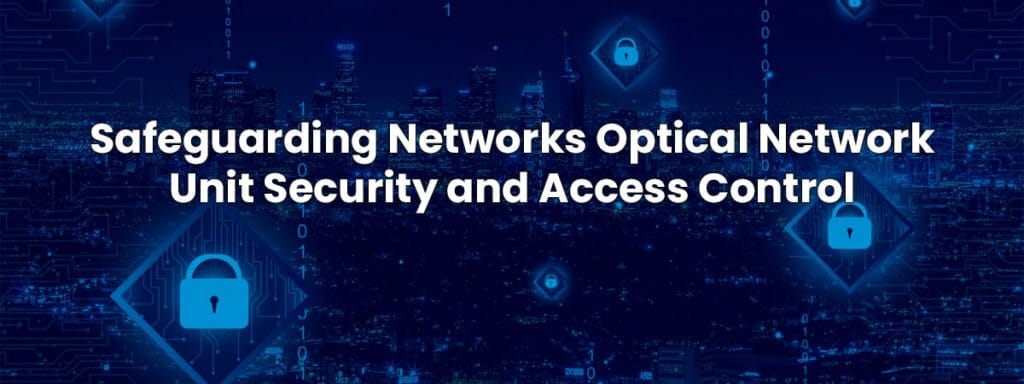Introduction
As the demand for high-speed connectivity continues to rise, ensuring the security and integrity of optical network infrastructure is of paramount importance. Optical Network Units (ONUs) play a crucial role in delivering fiber-based broadband services to end-users, making them a critical point of focus for network security. In this article, we will explore the significance of ONU security and access control and discuss best practices to protect network integrity, safeguard data, and mitigate potential vulnerabilities.
- ONU Authentication and Encryption
Authentication and encryption are fundamental security measures to protect the confidentiality and integrity of data transmitted through ONUs. Implementing strong authentication mechanisms, such as password-based or certificate-based authentication, ensures that only authorized users can access the network. It is crucial to enforce robust password policies, including complex passwords, regular password updates, and multi-factor authentication, to prevent unauthorized access to ONUs.
Additionally, encryption protocols, such as Advanced Encryption Standard (AES) or Secure Socket Layer (SSL), should be employed to secure data transmission between ONUs and the central network. Encryption ensures that data remains confidential and protected from eavesdropping or interception, even if it is compromised during transmission.
- Secure Configuration and Management Interfaces
The configuration and management interfaces of ONUs provide network administrators with control over the device and access to critical settings. Securing these interfaces is essential to prevent unauthorized modifications, unauthorized access to sensitive information, or potential network disruptions.
Network operators should ensure that default login credentials for ONUs are changed during installation to eliminate the risk of using default credentials. Implementing secure protocols, such as Secure Shell (SSH) or HTTPS, for accessing the management interfaces adds an additional layer of protection. Regularly patching and updating the firmware of ONUs also helps address any security vulnerabilities and protect against potential exploits.
- Access Control Lists (ACLs) and Firewall Policies
Access Control Lists (ACLs) and firewall policies are effective measures to control and manage network traffic at the ONU level. By configuring ACLs, network operators can define specific rules and policies to restrict or allow access to network resources based on IP addresses, protocols, or specific applications. This prevents unauthorized users or malicious entities from gaining access to the network, enhancing overall security.
Firewall policies further fortify ONU security by monitoring and filtering incoming and outgoing traffic based on predetermined rules. This helps prevent unauthorized access attempts, mitigates potential Distributed Denial of Service (DDoS) attacks, and protects against various types of network threats.
- Regular Security Audits and Monitoring
Performing regular security audits and implementing continuous monitoring practices are essential to identify potential vulnerabilities and detect suspicious activities within the network. Regular audits involve assessing the security posture of ONUs, verifying configuration settings, and conducting vulnerability scans to identify potential weaknesses.
Continuous monitoring with the help of Intrusion Detection Systems (IDS) or Intrusion Prevention Systems (IPS) enables network operators to detect and respond to security incidents in real-time. By monitoring network traffic, event logs, and system alerts, operators can promptly identify any unusual activity or potential security breaches, allowing for immediate action to be taken.
- Ongoing Security Education and Awareness
Building a security-conscious culture within the organization is crucial for maintaining strong ONU security. Network operators should provide ongoing security education and awareness programs to all employees, emphasizing the importance of following security best practices and recognizing potential threats.
Employees should be educated about the risks of phishing attacks, social engineering, and other common security threats. Regular training sessions can help reinforce good security habits, such as identifying suspicious emails, avoiding clicking on unknown links, and adhering to secure password practices. By fostering a security-aware workforce, network operators can create a strong line of defense against potential security breaches.
Conclusion
Securing Optical Network Units (ONUs) is a vital component of maintaining a resilient and trustworthy network infrastructure. By implementing robust authentication and encryption mechanisms, securing configuration interfaces, implementing access control policies, performing regular security audits, and fostering a security-conscious culture, network operators can protect their networks from potential threats. By prioritizing ONU security and access control, operators can ensure the integrity and confidentiality of data transmission, mitigate risks, and provide customers with a reliable and secure broadband experience.

